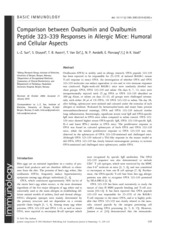| dc.contributor.author | Sun, Li-Zhi | en_US |
| dc.contributor.author | Elsayed, S. | en_US |
| dc.contributor.author | Aasen, T. B. | en_US |
| dc.contributor.author | Van Do, T. | en_US |
| dc.contributor.author | Aardal, N. P. | en_US |
| dc.contributor.author | Florvaag, E. | en_US |
| dc.contributor.author | Vaali, Kirsi Kaarina | en_US |
| dc.date.accessioned | 2012-06-28T07:50:13Z | |
| dc.date.available | 2012-06-28T07:50:13Z | |
| dc.date.issued | 2010 | eng |
| dc.Published | Scandinavian Journal of Immunology 71(5): 329–335, | en |
| dc.identifier.issn | 0300-9475 | |
| dc.identifier.uri | https://hdl.handle.net/1956/5865 | |
| dc.description.abstract | Ovalbumin (OVA) is widely used in allergy research. OVA peptide 323-339 has been reported to be responsible for 25–35% of isolated BALB ⁄ c mouse T-cell response to intact OVA. An investigation of whether OVA and OVA 323-339 molecules can induce equivalent in vivo and in vitro immune responses was conducted. Eight-week-old BALB ⁄ c mice were randomly divided into three groups: OVA, OVA 323-339 and saline. On days 0, 7, 14, mice were intraperitoneally injected with 25 lg OVA or OVA 323-339 absorbed on 300 lg Alum, or saline; on days 21–23, all groups were challenged intranasally with either 20 ll of 1% OVA, 1% OVA 323-339 or saline. On day 28, after killing, splenocytes were isolated and cultured under the stimulus of each allergen or medium. Evaluated by hematoxylin ⁄ eosin and major basic protein immunohistochemical stainings, OVA and OVA 323-339 induced similar lung inflammation. Interestingly, significant serum total IgE and OVA-specific IgE were observed in OVA mice when compared to saline control. OVA 323- 339 mice showed higher serum OVA-specific IgE, OVA 323-339-specific IgE, IL-4 and lower IFN-c similar to OVA mice. The proliferative response to OVA was found in cultured splenocytes of both OVA and OVA 323-339 mice, while the similar proliferative response to OVA 323-339 was only observed in the splenocytes of OVA 323-339-sensitized and challenged mice. Although OVA 323-339 induced a Th2-like response in the mouse model as did OVA, OVA 323-339 has clearly limited immunogenic potency to activate OVA-sensitized and challenged mice splenocytes, unlike OVA. | en_US |
| dc.language.iso | eng | eng |
| dc.publisher | Blackwell Publishing Ltd. | eng |
| dc.relation.ispartof | <a href="http://hdl.handle.net/1956/5866" target="blank">Toluene diisocyanate (TDI)-induced asthma: Inflammatory and immunological responses to TDI, ovalbumin (OVA) and ovalbumin peptide OVA 323-339 in mouse models</a> | eng |
| dc.title | Comparison between Ovalbumin and Ovalbumin Peptide 323-339 Responses in Allergic Mice: Humoral and Cellular Aspects | en_US |
| dc.type | Peer reviewed | |
| dc.type | Journal article | |
| dc.description.version | acceptedVersion | en_US |
| dc.rights.holder | Copyright 2010 The Authors. Journal compilation Copyright 2010 Blackwell Publishing Ltd. Scandinavian Journal of Immunology. | |
| dc.identifier.doi | https://doi.org/10.1111/j.1365-3083.2 | |
| dc.identifier.cristin | 522664 | |
| dc.subject.nsi | VDP::Medical disciplines: 700::Basic medical, dental and veterinary science disciplines: 710::Medical immunology: 716 | eng |
